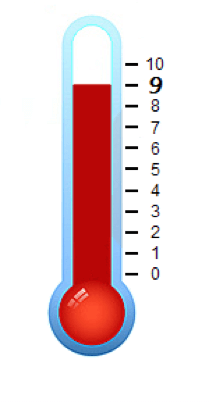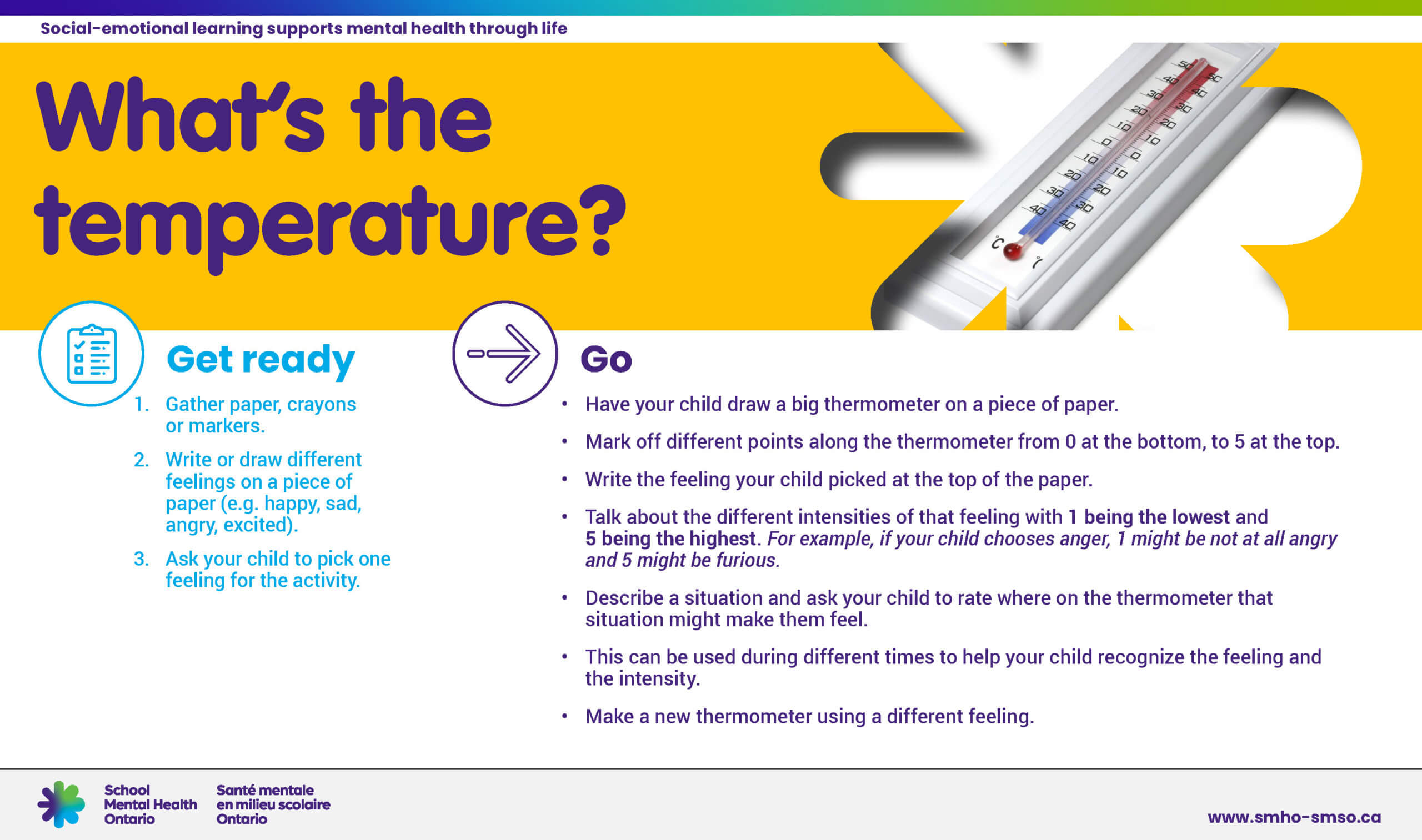


Time
10 to 15 minutes
Level
Primary / Junior / Intermediate
Material
Cardboard, paper, glue, crayons
Purpose
To teach students to take their emotional temperature, so they learn to recognize and regulate their emotions
 Discuss:
Discuss:
- A range of emotions that you want students to be able to identify.
- How might a thermometer be used to measure an emotional feeling?
- First, students make an emotion thermometer.
- Then, co-create an emotional vocabulary word bank for each emotion (happiness, sadness, love, disgust, anger, fear, and surprise).
- Demonstrate how to use the thermometer (e.g., identify their emotion and determine where they are on their thermometer).
- Students can use their emotion thermometer to gauge their emotion levels or to help them communicate their emotions to their teacher.
- Recognizing and acknowledging when emotions are intensifying are important steps toward emotion regulation.
See: Activities to try at home that connect to key areas of social-emotional learning

Get ready
- Gather paper, crayons or markers.
- Write or draw different feelings on a piece of paper (e.g. happy, sad, angry, excited).
- Ask your child to pick one feeling for the activity.
Go
- Have your child draw a big thermometer on a piece of paper.
- Mark off different points along the thermometer from 0 at the bottom, to 5 at the top.
- Write the feeling your child picked at the top of the paper.
- Talk about the different intensities of that feeling with 1 being the lowest and 5 being the highest. For example, if your child chooses anger, 1 might be not at all angry and 5 might be furious.
- Describe a situation and ask your child to rate where on the thermometer that situation might make them feel.
- This can be used during different times to help your child recognize the feeling and the intensity.
- Make a new thermometer using a different feeling.
- Students can also learn to express their feelings using emojis.
- Increase emotional vocabulary by introducing or reviewing a variety of ways to describe different levels of a particular emotion (e.g., annoyed, frustrated, irate, livid, furious, and outraged, etc. are different levels of anger).
- This can also be done with emojis for older students. Emojis can be used as an “exit ticket” from the lesson, or at the end of the day to check in with students about their feelings.
- For younger students: Each child can be given a mini popsicle stick with their name on it, and emojis can be put on a “pocket chart”. Students take turns putting their stick in front of the face that corresponds to how they feel, using a complete sentence (e.g., “I feel happy because…” or “I feel sad because…”).
- Help students connect emotions to something they can see, hear, or feel. Use a Looks Like/Sounds Like/Feels Like chart to explore the manifestations of a particular emotion, and to help students sense the subtle differences between their moods.
Using group activities to recognize and manage emotions engages students in beneficial social interaction, normalizes experiences of emotions, and provides students with a structured opportunity to share, and work with other students to improve their self-regulation abilities (Domitrovich, Cortes, & Greenberg, 2007; Slavin, 1995; Success for all Foundation, 2010).
Domitrovich, C. E., Cortes, R. C., & Greenberg, M. T. (2007). Improving Young Children’s Social and Emotional Competence: A Randomized Trial of the Preschool “PATHS” Curriculum. The Journal of Primary Prevention, 28(2), 67-91. doi:10.1007/s10935-007-0081-0
Slavin, R. (1995). Cooperative Learning: Theory, Research, and Practice (2nd ed.). Boston: Allyn & Bacon
Success for all Foundation. (2010). PowerTeaching Cooperative Learning Handbook. Retrieved from www.successforall.org
Understanding why and how we experience various emotions is honouring the connection between mind, body and spirit. As students practise ways to self-regulate, they become more fully alive. They develop emotional literacy skills, to live better, and thrive in their community.
(2b) An effective communicator who reads, understands and uses written materials effectively.
Demonstrating literacy and mathematics behaviours: to develop ways students use language, images, and materials to express and think critically about ideas and emotions, as they listen and speak, view and represent, and begin to read and write
Or, view all practices and use filters to find what you need
